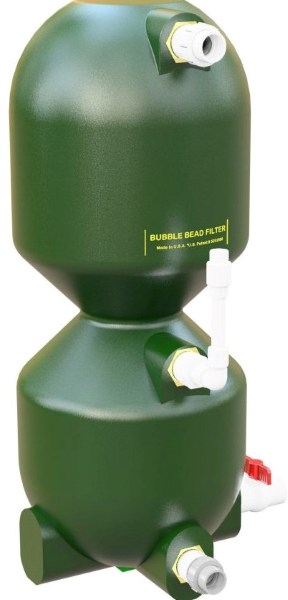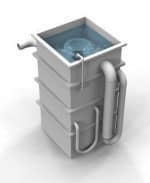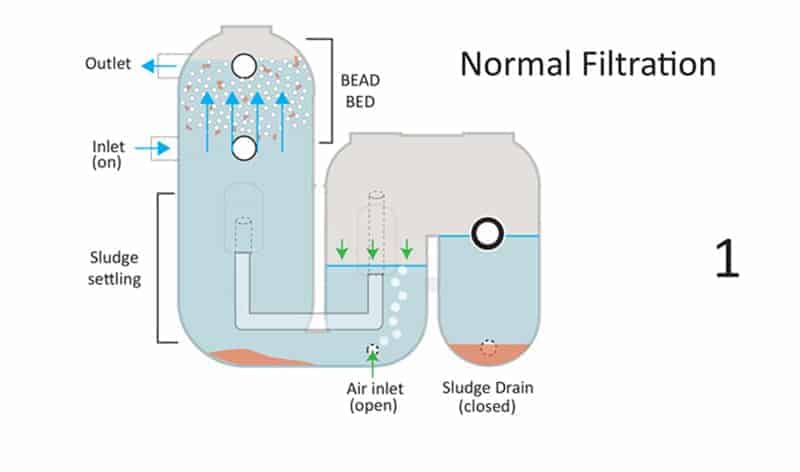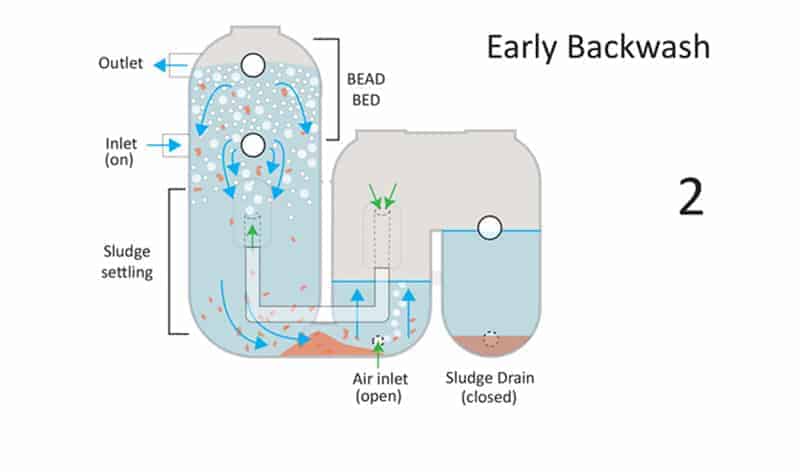AST Aquaculture Bead Filters – Bioclarifying aquaculture and wastewater filtration. Aquaculture Systems Technologies (AST) is the world leader in bead filter technology for recirculating aquaculture systems, ponds and wastewater. AST Aquaculture Bead Filters combine mechanical and biological filtration in one powerful unit, minimising footprint and maximising filtration power. Rely on AST and Pure Aquatics for your water treatment needs
The Bubble Bead Filter (BBF) is the entry level bead filter for lower stocking densities and feed loads. An easily back washed filter requiring no additional air pump, you can backwash this filter in a tuxedo. This filter is best utilised on ponds, aquarium systems and lightly loaded aquaculture systems.
The Propeller washed bead filter (PBF) is the workhorse bead filter for heavier feed rates and stocking densities. These filters can handle higher pressures, higher ammonia levels and higher feed rates due to their more aggressive backwash. Utilising a propeller driven by a motor mounted on top of the filter, the more aggressive backwash allows better control of the biofilm thickness and more waste to be removed at backwash time.
The Polygeyser comes in several variants but they all rely on the same backwash mechanism, Pneumatically triggered automated backwash. With the automated air backwash, flow does not need to be stopped. Back-washing can be set to certain intervals depending on loading and more frequent backwash’s means higher ammonia removal, greater solids removal, and better water quality.
Classic bubble bead filter offers robust, efficient, and dependable water filtration.
Bubble bead filter bioclarifier – bubble bead filters by ast offer easy maintenance and effective filtration.

Bubble differs from the Propeller Bead® and Polygeyser® bead filters in its simpler, yet very effective gentle backwash. The backwash is started by shutting off the circulation pump and opening the sludge valve. As the water drains from the filter, a check valve on the effluent line closes, creating negative pressure in the filter. The potential energy of the water leaving the filter pulls air in through the air inlet.
The results in the backwash expanding and agitating the bead media in a vigorous boiling type action as it passes downward through our unique washing throat. As the beads enter the lower expansion chamber, the downward velocity decreases due to the increased cross sectional area so the beads are suspended as the water washes the solids away from the beads and out of the filter.
Once the flow of the wastewater stops, the backwash is complete. Simply close the sludge valve and turn the circulation pump back on. Your filter is now in normal operation with a clean filtration bed.
The Bubble Bead® backwash is vigorous enough to remove unwanted solids and debris, yet gentle enough maintain a healthy bio-film on the bead Media. In fact, during testing the nitrification rate actually increased with increased backwash frequency.
PROPELLOR WASHED BEAD FILTER -DESIGNED FOR HIGH FLOW AND HIGHLY LOADED SYSTEMS.
Utilized at some of the largest recirculating fish production facilities, zoos, and aquariums, the Propellor Washed Bead filter accepts versatile loads ranging from low to high solids due to the active motorized backwash system.
The motorized embedded propeller is used for frequent washing of the media, removing captured solids and excess media biofloc. The sludge then settles to the bottom of the unit where it is drained, reducing water loss that is normally associated with backwash processes. With Propeller Bead filters, you will only lose 10% of the water you that you would normally lose with run-of-the-mill sand filters.
AST has both standard flow and high flow (pressurized) Propeller Bead filters. High flow filters can process flow rates of up to 1200 gpm, making them perfect for large systems that need frequent turnover.
Suitable for high loads that are typical of aquaculture applications, these filters are capable of handling ammonia loads 50% – 100% higher than standard bead filters. You will be able to lower your overall water and head loss – our innovative backwashing process is gentle enough to protect the biofilm and keep the environment healthy.

The Propeller Bead® filter has the most aggressive backwash of any of AST filters. Delivered by a motorized propeller that vigorously mixes the beads, the water enters through the side intake and exits from the top of the filter, trapping solids within the floating media bed.
When back washing, the pump is turned off and the water inlet valve is closed. If the system is pressurized, it must be released before operating the mixing motor. The mixing motor is turned on for 15-45 seconds until the beads fluidize. The mixing motor is shut off and the solids are allowed to settle for ten minutes minimum. Opening the drain early risks losing beads, and the solids will not be drained. The sludge valve is opened, and the concentrated sludge is allowed to gravity drain from the filter. Backwash frequency is dictated by feed rate.
After sludge is drained, the sludge valve is closed and the inlet valve reopened. Turning the pump back on puts the filter back into normal operation.


The AST Polygeyser Bead filter is AST’s patented line of beadfilters featuring a breakthrough in filter technology: automatic pneumatic backwash for hands-off maintenance and low water loss. Learn more about our unique PolyGeyser filters below, or contact the AST team and we will help you choose the perfect PolyGeyser for your application.
The PolyGeyser filter is a breakthrough in filter technology. It is very different from most filters on the market due to its auto-pneumatic backwash mechanism. Water enters below the bed of enhanced nitrification media and travels upward through the filtration chamber where mechanical and biological filtration take place. Simultaneously, air is introduced into the charge chamber at a constant predetermined rate to achieve the desired backwash frequency.
Once the charge chamber has reached capacity, the pneumatic trigger fires, releasing the entrained air from the charge chamber below the bead bed. The sudden release of air from the charge chamber causes the beads to mix as the air agitates the beads. As the beads drop, the bead bed expands downward while simultaneously water rushes downward through the expanded beads, sweeping the solids away and into the air charge chamber.
In the chamber, the solids settle out from the backwash waters and are later removed from the filter. Essentially, this type of filter recycles the backwash water while concentrating the waste products so that you have extremely low water loss while maximizing the nitrification capacity.
Frequent backwashing has proven advantageous for optimizing the nitrification capacity of a PolyGeyser filters. Numerous gentle scrubbing cycles promotes a higher rate of nitrification by maintaining a healthy thin biofilm on the surface of the bead media. Typical backwash cycles occur every 3-6 hours.’
PolyGeyser® Bead Filters are the newest addition to Aquaculture Systems Technologies’ line of Bead Filter Technologies. The patented PolyGeyser® Bead Filters (U.S. Patent # 5,770,080 and 6,517,724, European Patent # 0977713B, and Canadian Patent # 2,287,191) utilize the same filtration mechanism as all of our bead filters namely water from the aquatic system passes upward through the packed bed of plastic beads. The beads capture the solids, while simultaneously providing a large surface area (400 ft2 /ft3 ) for the attachment of nitrifying bacteria which remove dissolved nitrogenous wastes. Bead filters are excellent clarification units, capable of maintaining display quality water at high waste loading rates. Studies have shown that Bead Filters capture 100% of particles > 50 microns and 48% of particles in the 5-10 micron range per pass.
Under development for several years, the PolyGeyser technology exploits the biofilm protection provided by our Enhanced Nitrification (EN) Bead Media. Additionally, the PolyGeyser® Bead Filters offer a very high degree of reliability and are virtually resistant to clogging and caking by virtue of the fact that they backwash automatically using no moving parts or electronics. As a “bioclarifiers” the PolyGeyser® are capable of handling ammonia loads 50 to 100 percent higher than standard bead filters, at a fraction of the water loss and head loss!

These filters offer superior biofiltration and an innovative automatic pneumatic backwash mechanism with no moving parts or electronics.

Perfect for smaller, more compact systems and applications, these filters features automated backwash for easy maintenance.

These low profile filters are made for large volume applications. They are pump-configurable and feature airlifted technology for advanced energy savings.

These new filters feature automated backwashing and are capable of handling large volumes of water under pressure, while gently backwashing the media.

These units are intended to operate for months with periodic pass-bye inspection to assure that the air blower and input pumps are operating. The air blowers drive the recirculation loops and only the beads, water, and air move within the unit – there is nothing to break, not even a check valve. These filters can even be buried, as all vital components can be reached from the top.
Endurance Polygeyser Bead filter – an advancement of our patented PolyGeyser® technology with the addition of many new enhancements and increased performance features.

These exceptional filters backwash automatically, several times a day. The user does not need to turn off the pump or close any valves during the backwash sequence. The filter does not require an electric timer. The backwash cycle is regulated by the air that is injected into the charge chamber. The filters clean and recycle the dirty water produced in backwashing every two to three hours. Sludge is only removed once or twice a week.

The water moves from the inlet up through the bead bed. The bead bed provides surface area for the water purifying bacteria and captures solids within the aquatic system. Air is slowly injected into the charge chamber, gathering in the top of the filter. As more air enters, this places downward pressure on the water level. The water level drops trapping water in the settling zone, and solids from the last backwash settle into the sludge basin. The rate of air injection controls the length of time between backwashing events.

Air has made its way through the trigger into the bead bed. The bubbles agitate the beads; knocking solids and biofilm off the beads. As the air pressure in the charge chamber drops, the dirty water from beneath the bead bed sweeps through the chute carrying the solids into the adjacent compartment. No water flows out of the filter during the short 3 – 5 second backwash event; instead the dirty backwash water is captured in the charge chamber and the sludge basin. The beads float in the drop zone where they continue to be scrubbed by the escaping bubbles.

Water flows downward through the mixing bead bed and more solids are washed from the beds to settle towards the bottom. The downward flowing water sweeps into the middle compartment, flushing the solids that have accumulated on the bottom of filter and depositing them into the sludge basin. The water level rises in the shorter chambers.

Eventually the water rising in the sludge chamber floods the trigger, bringing water movement in the charge chamber and sludge basin to an end. Trapped solids begin to settle as the filtration chamber is refilled with the water from the inlet. The beads float back in place to reform the bead bed. As soon as the water rises to the outlet, filtration resumes.

At the end of the backwash, the beads rise back to the top of the filter. Most settled solids have been swept to the sludge chamber. The filter will continue to filter and backwash itself several times a day. After the sludge has built up, the user can open the sludge valve to drain the concentrated sludge from the filter.
The filter backwashing frequency is usually set for a few hours, so the filters will backwash several times a day. Sludge accumulates in the sludge basin. Every few days, perhaps once a week, the sludge drain must be opened to let the sludge out. A natural fertilizer, the sludge can be poured out on the lawn or nearby plant where it will naturally degrade.











The Recirculating Polygeyser Wastewater Filter uses the same proven filtration technology as our traditional PolyGeyser but has been optimized for biofiltration. The unit is designed with a built-in recirculation basin for improved treatment of domestic, industrial, and agricultural wastewaters for TSS, BOD and ammonia removal. Discharging water only when new wastewater is added to the internal recirculation basin, flow can be adjusted to meet virtually any discharge expectation.
The backwash frequency of the filter can be adjusted to optimally manage biofilms to avoid biofouling. An optimally tuned pneumatic backwashing combined with EN media encourages the development of slow-growing bacteria for the treatment of refractory organics associated with BTEX and MBTE typically found in groundwater contamination. This unit is an excellent choice for treating poorly defined industrial wastes as it can attack both particulates and dissolved contaminants without much concern about oxygen or biofouling.
Recirculating Polygeyser Wastewater Filter’s are tall filters (up to 10 feet) with high bead bed capabilities ranging currently from 10 to 250 cubic foot with internal recirculation flows ranging from 100 to 2,500 gpm. Normally equipped with auto-pneumatic sludge discharge, these units are intended to operate for months with periodic pass-bye inspection to assure that the air blower and input pumps are operating. The air blowers drive the recirculation loops and only the beads, water, and air move within the unit – there is nothing to break, not even a check valve. These filters can even be buried, as all vital components can be reached from the top.
DESIGNED FOR HEAVY LOADS ASSOCIATED WITH FULL SCALE COMMERCIAL TREATMENT.
| Filter Model | Bead Volume(ft3/m3) | Dimensions(ft/m) | Flow Rates*(gpm/m3hr-1) | MaxRecirculation Rate(gpm/m3hr-1) | TAN Conversion+(kg/day) | BOD Removal–(kg/day | ||
|---|---|---|---|---|---|---|---|---|
| 1 mg/L | 5 mg/L | 10 mg/L | 20 mg/L | |||||
| RCPG 10 | 10/0.28 | 5’6’’x 3’9’’x 5’1.7mx1.1mx1.5m | 1-10/0.27-2.7 | 100/27.3 | 0.3 | 0.2 | 0.3 | 0.4 |
| RCPG25 | 25/0.71 | 6’ dia. x 6’ h1.8mx1.8m | 1-25/0.27-6.8 | 250/68.3 | 0.9 | 0.5 | 0.8 | 1.1 |
| RCPG50 | 50/1.4 | 7’2” dia. x 7’6” h2.2mx2.3m | 1-50/13.5 | 500/136.5 | 1.7 | 1 | 1.5 | 2.3 |
| RCPG 100 | 100/2.8 | 10’ dia. x 9’3’’h/3mx2.7m | 1-100/0.27-27.3 | 1000/273 | 3.3 | 2 | 3 | 4.5 |
| RCPG 250 | 250/7.1 | 10’ x 12’ x 10’/3mx3.6m/3m | 1-250/0.27-68.2 | 2500/682 | 8.5 | 5.1 | 7.6 | 11.3 |
* Flow rates are based on loading and desired effluent quality. Listed are typical flow ranges.
+ TAN conversion is based on 1.2 kg/m3-day VTR which is the TAN conversion rate at an effluent quality of 1 mg/L and a temperature of ≤15 ºC. Effluent qualities or temperatures below these standards may result in lower TAN conversions.
– BOD removal rates are based on the effluent BOD concentration of the unit. As the concentration increases, the removal rate increases. Provided are three typical effluent qualities and the corresponding removal rates.
THE SELF-AUTOMATED BACKWASH PROCESS REQUIRES NO MOVING PARTS OR ELECTRONICS.
The PG Polygeyser Bead filter has been under development for several years, the patented PolyGeyser® technology is capable of handling ammonia loads 50% – 100% higher than standard bead filters at a fraction of the water loss and head loss.
The innovative backwash process of the Polygeyser prevents caking and clogging – keeping your day-to-day operations moving along smoothly. The backwash is gentle, keeping the biofilm intact while allowing the system to operate for long periods of time with no maintenance.
PolyGeyser® Bead Filters are the newest addition to Aquaculture Systems Technologies’ line of Bead Filter Technologies. The patented PolyGeyser® Bead Filters (U.S. Patent # 5,770,080 and 6,517,724, European Patent # 0977713B, and Canadian Patent # 2,287,191) utilize the same filtration mechanism as all of our bead filters namely water from the aquatic system passes upward through the packed bed of plastic beads. The beads capture the solids, while simultaneously providing a large surface area (400 ft2 /ft3 ) for the attachment of nitrifying bacteria which remove dissolved nitrogenous wastes. Bead filters are excellent clarification units, capable of maintaining display quality water at high waste loading rates. Studies have shown that Bead Filters capture 100% of particles > 50 microns and 48% of particles in the 5-10 micron range per pass.
Under development for several years, the PolyGeyser technology exploits the biofilm protection provided by our Enhanced Nitrification (EN) Bead Media. Additionally, the PolyGeyser® Bead Filters offer a very high degree of reliability and are virtually resistant to clogging and caking by virtue of the fact that they backwash automatically using no moving\ parts or electronics. As a “bioclarifiers” the PolyGeyser® are capable of handling ammonia loads 50 to 100 percent higher than standard bead filters, at a fraction of the water loss and head loss!


EXPERIENCE ENERGY SAVINGS OF UP TO 60% BY USING AIRLIFT TECHNOLOGY INSTEAD OF EXPENSIVE WATER PUMPS.
The Low Profile Polygeyser allows a filter configuration that moves water using an air blower instead of a standard water pump, lowering power consumption and removing the need for expensive, mechanical equipment. Are you more interested in a standard water pump configuration? These filtration systems can move water via pump or airlift; the versatility of our airlift filters creates a customizable solution to fit your unique needs. These low-profile filters are also suitable for water pumped configurations.
Smart, efficient designs that only remove concentrated solids (minimizing water loss and optimizing efficiency).
Like all of AST’s bead filters, AST Low Profile PolyGeyser filters provide both mechanical and biological filtration in one, single unit. Thanks to patented PolyGeyser technology, these filters offer automatic backwashing that minimizes water loss by removing ONLY concentrated solids (sludge).

Durable fiberglass construction, made in the U.S.A.

The Robust High Profile PolyGeyser Can Handle High Water Pressure with Finesse.
The new High Profile Polygeyser Beadfilter Filter (HPPG) is perfect for high volume applications from large aquatic life support systems to wastewater treatment and clarification. Capable of handling large volumes of water under pressure, these PolyGeyser filters gently backwash the media, multiple times a day, to maintain a healthy biofilm. The enhanced nitrification capacity makes this unit ideal for applications with high biofiltration needs.
PolyGeyser filter technology pneumatically backwashes the media regularly, without manual intervention, moving parts, or controllers. This filter provides both mechanical and biological filtration with extremely low water loss by recycling its backwash water and only removing sludge after it has concentrated in the sludge chamber.
This new design pairs the high-pressure tolerance and flow rates attained in Propeller Bead® Filter models with the convenience and efficiency of a PolyGeyser. Now you can enjoy the ease of maintenance and save water with a PolyGeyser filter in high pressure applications.

High Profile Polygeyser Beadfilter used for a 45,000 gallon koi pond. Includes pump, filter, and UV system in the configuration.